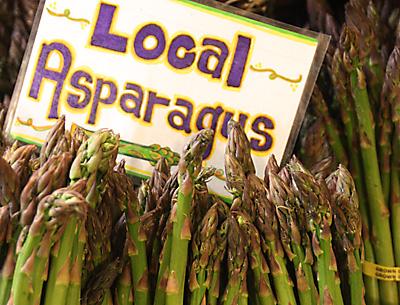Seasons by the Sea: Spring Tips

Spring is here and with it comes one of the best vegetables, asparagus. Available at farmers markets, local asparagus can be found in chopstick-thin stalks, Sharpie-pen fatties, and even some violet-tinged varieties. You can steam, boil, stir-fry, roast, grill, microwave, and pickle asparagus. Serve it hot, at room temperature, or cold. Puree it into soups. Save some tips for risottos. You can even shave it raw into salads.
Asparagus is a bit tricky and time-consuming to grow, hence the often-hefty price tag. The plant requires three to four seasons of growing before the first stalks can be harvested. It also has a short lifespan, requires careful tending, and must be harvested by hand.
The French are quite fond of white asparagus, which has been shielded from the sun, preventing photosynthesis. Some believe this version of asparagus (raised like veal, as far as I’m concerned) is sweeter and more delicate than the green. I find it blander, a bit tougher, quite boring. But it makes a fine vehicle for transporting hollandaise sauce into your mouth.
Asparagus officinalis is a member of the lily family and distantly related to onions and other alliums. The name “asparagus” was used in classical Greece and Rome and can be traced back to the Persian work “asparag” meaning a sprout. “Sperage” was used in the 16th and 17th centuries, then “sparagus” and the adorable “sparrow grass.” The early Greeks did not cultivate asparagus but the Romans grew it in their gardens for culinary and medicinal uses. After the fall of the Roman Empire, asparagus cultivation continued in Syria, Egypt, and Spain. Asparagus arrived in France around 1469 and in England by 1538. China is now the largest producer, followed by Peru and Germany. In the U.S. most asparagus is grown in California, Michigan, and Washington.
Because freshly harvested asparagus is very juicy and noticeably sweet, it is important to consume it shortly after picking or buying, just like corn. Once picked, the still actively growing shoot starts to consume its own sugars, faster than any other vegetables and mostly within the first 24 hours. A good storage solution is to trim the woody ends and store the stalks upright in a jar with a few inches of slightly sweetened water. Place a plastic bag over the tips, and try to enjoy your asparagus within two days. When purchasing, look for tight tips with no additional sproutage. They should also be snappy and firm, not soft and limp. Check the ends, they shouldn’t look too woody and dry. The thicker stalks can be shaved with a vegetable peeler so you can use more of them.
And what, I know you are wondering, causes your pee-pee to smell after consuming asparagus? This is a sulfur-containing substance, asparagusic acid, a close relative of skunk spray called methanethiol. This passes through your bloodstream so quickly it can be detected within 15 to 20 minutes after consumption. But don’t ever let this odd little side effect deter you from enjoying asparagus. It is full of folate, potassium, antioxidants, vitamin C, and fiber. Some believe it helps dissolve uric acid deposits and ease hypertension. South Korean scientists recently did a study and now they believe it helps cure hangovers. But if you ask me, they should be more concerned with that fat little sprout to the north, Kim Jong Un.
Another question that pops up when discussing asparagus is what kinds of wine go with it. Some say a simple sauvignon blanc or gruner veltliner. Asparagus, like artichokes, can have a strange flavor when consumed with the wrong beverage.
My favorite way of preparing asparagus is roasting it tossed with olive oil in a hot oven, 450 degrees, for about 5 to 15 minutes, depending on the thickness of the stalks. I then sprinkle on a bit of lemon juice or a few shavings of Parmesan cheese, followed by lots of chopped chives, salt, and pepper. It’s also excellent grilled on the barbecue. When I serve it with a vinaigrette, I use a mild sherry or champagne vinegar, shallots, and good olive oil. Other ingredients and flavors that are wonderful with asparagus are anchovies, orange zest, pesto, Hollandaise, mornay sauce, mustard, salmon, and bacon.
Get this spring delicacy now while you can and try to find it at the farmers markets. It should be available through June.
Click for recipes
